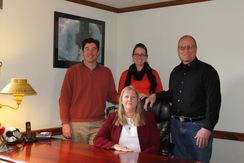Thursday, February 4, 2016
TAX TIME TIPS FOR ALPACA BREEDERS

By Lori Oraschin of Oraschin & Associates and Harley Hill Farm Alpacas
In the midst of preparing approximately 350 income tax returns, and over 60 of them are alpaca farmers, I thought it would be a good time to choose a few points that could help save you tax dollars if you have not completed your tax return for last year AND a few pointers to consider that may help you this time next year as you prepare your 2015 returns.
1. Bonus Depreciation – If you purchase a NEW asset, it would be eligible for 50% BONUS depreciation. Why is this important? You would be able to deduct 50% in the year of acquisition, then depreciate the other 50 percent over the depreciable life of the asset.
2. IRS Section 179 – Expensing the purchase of Farm Assets – This IRS provision will allow you to completely write off the cost of purchasing NEW and USED, equipment, alpacas, fence, run-in-sheds – BUT not GENERAL PURPOSE BARNS (20 year asset) See Above – you could use the 50%BONUS DEPRECIATION for the barn
***warning***You cannot use Sect 179 to further put a farm into a larger loss, unless it is against other positive “earned income” ie: W2 wages or profits from another business.
3. BUYING on TERMS – If you purchased an alpaca or equipment on terms, but did not fully pay for the animal or equip in 2015, be sure to include the FULL purchase price in your 2015 TAX RETURN. You can either depreciate the full amount over 5, 7 or 10 years, or take advantage of the Sect 179 provision above to write off the full cost. see *** warning*** above.
4. SELLING on TERMS – If you sold an alpaca and you are still getting monthly payments, you ONLY need to include the payments that were received during the year – this income is reported as an installment sale – IRS Form 6252
5. We all want to make a profit in the alpaca farming business! In an agricultural livestock breeding business, it is very important to take advantage of selling your alpacas as a business asset on IRS Form 4797 (if eligible) rather than on the Schedule F, and take advantage of the 15% maximum long term gain rate on farm assets held more than 1 year. IF you are in the 15% bracket – THEN – sale of long term farm assets are taxed at 0% - YES ZERO PERCENT! – This truly is how you can have a nice farming profit and not pay any federal tax!!!
OK – so here is the rule
Post the sale of all of your alpaca fiber and products on the Schedule F
Post the sale of alpacas born on your farm, and less and 1 year old on the Schedule F
Post the sale of alpacas purchased and resold within 1 year on Schedule F
ALL OTHER ALPACA SALES SHOULD BE ON FORM 4797 (this tax provision if NOT for as breeder who only raises alpacas for sale, but rather for a breeder who produces and sells fleece, and sells alpacas to manage the size of the herd)
6. Think about paying your children wages for their work on the farm in 2016. If your children (not grandkids) are between the ages of 12 and 18 – then you can pay them without withholding any Social Security, Federal or State tax from their wages.
7. The following is a list of a few commonly missed farm deductions that you should be able to allocate a percentage of, and deduct on your farm return.
Disposal
Computer and Office expense
Meals away from the farm for farm related activity
Farm publications
Part of your homeowners insurance
Part of your internet/phone/ and electric
8. There is a Fuel Credit for gallons purchased at the pump used “off road” on your farm.
Lori Oraschin and her husband Bill Oraschin reside at Harley Hill Farm in Quakertown PA along with 40-50 alpacas at any given time. Lori has presented seminars at many aaca and agricultural organization events. They have many events and seminars at their farm throughout the year including The Mommy and Me Alpaca Event.Be sure to check their website at www.harleyhillfarm.com for the next opportunity to learn more about how you can save using Tax Tips for Alpaca Breeders.